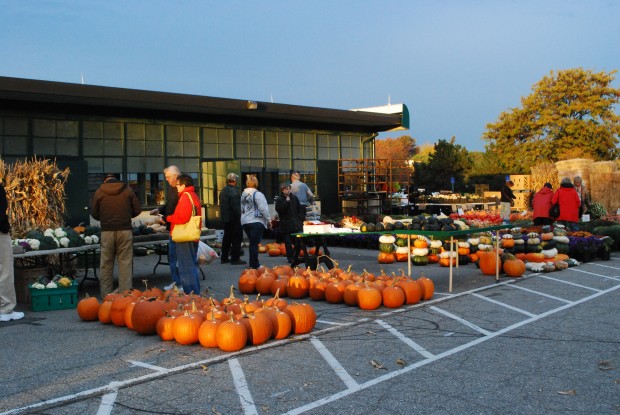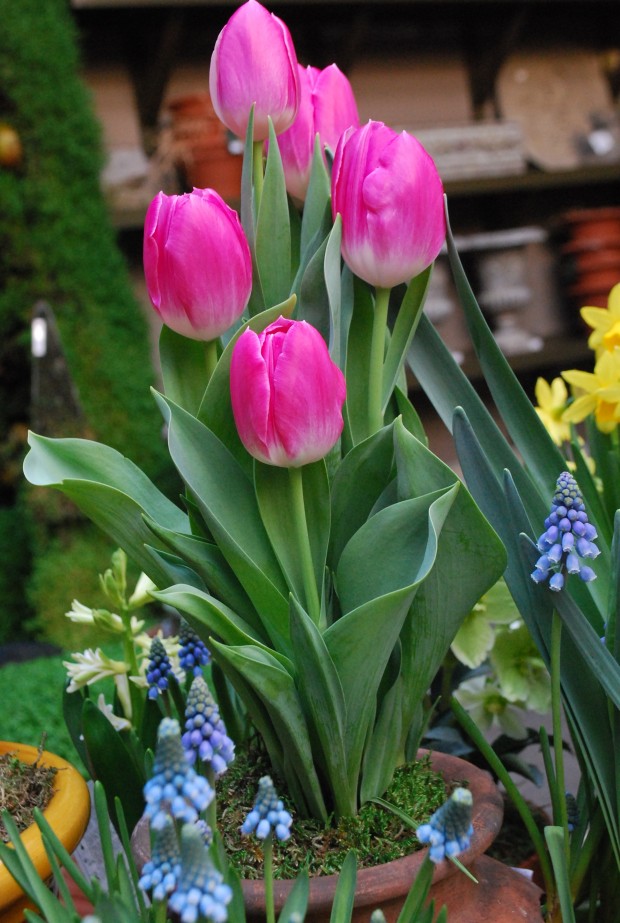Deborah Silver is an accomplished and experienced landscape and garden designer whose firm first opened its doors in 1986.
The landscape lighting I have at home was confined to some path lights along my front walk-nothing else. The path lights had all but disappeared into the boxwood, given how much it has grown since those lights were installed. In the summer, it is easy to see and navigate the steps coming up to the front door. Once the days get shorter and the weather cold, I am not out here. But every time we have company in the late fall or winter, I worry that someone will trip and fall. Last winter, two older dinner guests fell into the boxwood. They thought it was hilarious-I was mortified. It was time to call a lighting person. Lighting the landscape serves multiple purposes. It helps provide for safe passage, it provides security, and it can add another dimension to the late fall and winter garden.
My front porch is enclosed; their are 4 porch lights on the inside. This is not much help to someone walking up the steps to the front door. The glare from the inside light made the porch steps and front door even darker. My first request-a pair of small spot lights mounted on the underhang which would illuminate the door. That warm light from these two small fixtures does a good job of saying “we are expecting you”. Second on my list-the path lights buried in the boxwood.
Path lights direct the light down and to the side. Light shining into the eyes of someone walking up would make the trip even more difficult. The metal hats direct the light where it needs to be. Once the new risers were installed, the front walk was illuminated such that anyone could walk up comfortably and confidently.
The lighting designer suggested lighting the walls of the front of the house. That fire brick from the 1930’s is lovely. Washing the walls with light at night features that architectural detail, and the relationship of the house to the landscape. These wider fixtures illuminate a wider area than a spot light, or path light.
Placing the fixture in the right spot can be tricky. The fixtures in my landscape are strictly utilitarian. They are only as big as they need to be, and they are black. I did not want to see them during the day. Not only do they need to be hidden from the daytime view, they need to be the right distance and angle from the wall so as to wash the wall with light. A wall drenched with light might be a good idea for a commercial building or a theatre production, but can easily overwhelm a residential landscape.
I have a container planted with a yew topiary at each end of the house; they I did want to softly light them. A pair of fixtures can be seen at the bottom of this picture. As the fixture needed to be disguised in the boxwood, I needed two lights in order to get the light to cover the pot evenly.
The light on the right brushes the boxwood a little too harshly. The bottom of the pot has no light. For obvious reasons, a landscape contractor has to do the work of the installation during the day. This makes it very important to contract with someone who is willing to look at the job at night, and make any necessary changes.
The original path lights on risers solved the issue of lighting the walk. Though I do not have very many people coming to my front door, how this looks at night is attractive and warm. The best antidote I know of for the winter blues is some light.
I also have 4 pots which face the street. They are perfectly visible in the summer, but I fill them with twigs, greens, and other materials of the season for the winter. Though I put lights in my pots, an evenly applied landscape light on the face will permit those pots to be seen all winter. Given that it is dark here by 5pm in the winter, that lighting will be much appreciated. Though I am not out there in the winter, I drive by my house every day on my way to the driveway.
For some years I have been pruning the yew hedge on the street side of the pots so the entire pot and planting could be seen, top to bottom. This pair of spotlights are unobtrusive during the day, but will be very effective at night.
On the first go around, it seemed to me that the lights were too close to the pots, and the wattage too high. This look might be great around the holidays, when too much light is enough to make you smile, but for an average gloomy winter day, it is too bright. We have since moved the lights further away, and dialed down the wattage.
The light is too strong here too. There should not be any light pattern on the wall; the light itself should be dim, and even. The light on the topiary is so strong that the color is washed out.
From this picture I have been able to make changes. The front porch lights will stay as they are-strong in a downward direction. The path lights do the job they need to do, in the same downward direction. The lighting on the walls and pots-much too strong. A lighting scheme needs as much simplicity as a good landscape scheme. Subtle and useful lighting takes time and patience to achieve, but I think I am going to be happy with the results.
The picture I took of the sky this morning does not really capture that glowing gold and pink light that warmed everything in the landscape it touched. October skies have those moments that can take your breath away. This beautiful light blew in like a sudden squall-I could see it would not last long.
The field next door was awash in pink gold light. So beautiful! The intense quality of light in a sunny summer garden is very different than the filtered light of a spring shade garden. The flat light that characterizes our gray Michigan weather is a far cry from this golden fall light. When you design, think about what light will do for, or in spite of, your composition.

Light dramatically affects the appearance of a garden or landscape. I read, and I look at no end of photographs of landscapes. A landscape photographed under that very special and ephemeral October light looks dramatically different than a landscape photographed in the glare of the summer sun, or the gloomy light of winter. Plan for both.
I do think light is a key element in good landscape design. Dark areas may ask for chartreuse leaves or white flowers. Bright areas may ask for something entirely different. Dark foliage and shapes may benefit from a sunny placement. Great landscapes stand up to, and engage whatever light is the daily special. In any event, a consideration of the light, no matter the season, should play a considerable part in the design process. When I photograph a garden or landscape, I wait for that natural light that will make for the best picture. But I cannot count on that light for more than a moment.
The nicotiana in the shop garden has been delightful since late May. Who knows why the planting was never plagued by aphids. I amazed that they did not go out of bloom entirely during this summer’s scorching heat. This level of investment in nicotiana was in spite of my better judgment. Who has any idea how a plant will fare in any given summer season? I bought a ticket with no options for a change or upgrade. I was lucky. The nicotiana still looks beautiful. In the light this morning, this mass of nicotiana looked great. I was faithful about the water, and the care, but how they look in mid October-much about the nature of the season and the low light.
Our farmer’s market was similarly endowed by the gorgeous October light this morning. Every pumpkin was on fire-irresistable in form and color. Light does an incredible job of describing forms. Hve the idea to assess the effect of light? Look at your landscape every day, in all kinds of weather. A tree viewed from the front side of the light appears incredibly different than a tree which is back lit. The low angle and intensity of the early morning golden light made everything in my immediate view look good-vibrant and juicy.
Julie’s Floral at the Oakland County Farmer’s Market specializes in fine and unusual 4″ plant material, water plants, vines, dahlias, and topiary plants from the very beginning of the market summer season to the end. They also grow cutting flowers. The light this morning made their flowers glow. Did I buy? Oh yes.
This group of pumpkin stacks looked especially good this morning. A stack of pumpkins is not so much my thing, though I would applaud the sculptural look of a 10 or 30 of stacks. Set level, and in a shape or arrangement that enchanted my eye. Some expression asks for lots. The sculptural look of these stacks this morning was much about the light.
Chinese lanterns, or Physalis, mature in October. Their color ranges from gold to intense orange. Given the gold light this morning, I could not take my eyes off of them. They glowed orange. The rectangular shape and pale green color of the stems, in contrast to those orange lanterns, tell an engaging visual tale about the fall garden.
Fall asters-their willing bloom and clear color make them a favorite in a fall garden. This morning they were achingly beautiful. That October light made me want to take all of them home.

Marlene had bunches of peppers suitable for drying for sale this morning. She is a first rate grower, horticulturist, and farmer. She is an outstanding gardener and grower. I can count on finding what I never expected from her. The colors of her peppers were so brilliantly saturated. Laying eyes on these bunches made me so glad that I had gotten up early. How any gardener chooses to light their garden, and their gardening life- extraordinarily important.
The last two nights have been astonishingly cold, considering it is early October-not early November. This morning, my brown sweet potato vines were limp-the effect of too much cold, and gravity. The summer season is indeed coming to a close. Most of my pots have been cleaned out. The olive tree and rosemary have been repotted, and have been brought into the greenhouse.
The red leaved hibiscus looks much like the potato vine-all of its spirit has drained away. The summer season is coming to a close much faster than I bargained for. But I have a spring ahead, that needs my attention. The spring flowering bulbs need to be planted now, if I plan to see them begin to bloom next March.
There are lots of good reasons not to plant bulbs. The air temperature is cold-the soil temperature is wet and cold. Planting brown orbs is momumentally unsatisfying. Once placed below ground, there is nothing to show for the effort. The fruits of the efforts are months away. Do you remember where you had crocus, and where you need more? I don’t either.
Can you remember where you thought a few more alliums would be good? Me neither. Are you tired to the bone from trying to keep your garden watered in extraordinary heat that characterized this season, and irritated about the lack of rain? Can we not get some rain?
As irritating as a frustrating gardening season can be, the future requires a fresh eye. At this time of year a fresh eye takes the form of a round, brown, and plump bulb. Or in the case of anemone blanda, a brown, wrinkled and dry bulb.

It is a miracle of nature-how a tulip and its flower and leaves are sleeping, entirely contained inside a bulb. A tulip bulb is a small, fairly round, and brown papery promise of what is to come.
Number one grade daffodil bulbs are more complex in shape-but they are just as brown and inert. Globemaster Allium bulbs are quite large, and juicy looking. Allium albopilosum-is anyone in there? I understand that when my fall bulbs arrive, they are dormant. They need planting. They need a cold period of a good many weeks. But to look at them, it is hard to imagine the life that is inside.
Spring blooming crocus are such a relief in March. They are not so expensive-it is very easy to sign up for a hundred or more. Once those 100 bulbs arrive, the thought of planting one hundred of anything seems formidable. The small package that they arrive in is easy to loose track of.
All of this said, I would be most disappointed in myself if spring arrived, with no spring flowering bulbs breaking ground. I would only have myself to blame. It would just be much better if I could break free of that image of my cold sacked potato vine, and invest in my future.
I rarely plant spring flowering bulbs in the ground. Most of what I do in ground involves crocus, hybrid trout lilies, and snow drops. Planting bulbs in pots is easy, quick-and eminently satisfying.
I am not interested in forcing bulbs. Other people/nurseries do this far better than I could ever hope to do. Do I buy forced bulbs in March-yes. Anythoing that blooms in March lifts my spirits. My personal plan- I like potting up bulbs in planters, and storing them in the garage. I bring them out in March-the first hint of spring. They bloom at the same time that they would bloom, if they were planted in ground. They bloom on time, and in season-without all of the headache of digging in an in ground planting.
Potting up bulbs in containers is so easy. I use a good compost loaded soil mix. I plant the bulbs shoulder to shoulder. Planting them in fiber pots means they can be dropped into a treasured container come spring without much fuss. Clay pots, concrete pots, fiber pots-I plant loads of bulbs in containers. Tulips on my front porch in spring-love this. Little pots of crocus or muscari dress up a spring table.
Best of all, the fall planting/spring blooming bulbs speak strongly to the hope for the future garden. Every serious gardener makes something grow.
Making something grow is a very good idea.
Deborah Silver is a landscape and garden designer whose firm, Deborah Silver and Co Inc, opened its doors in 1986. She opened Detroit Garden Works, a retail store devoted to fine and unusual garden ornament and specialty plants, in 1996. In 2004, she opened the Branch studio, a subsidiary of the landscape company which designs and manufactures garden ornament in a variety of media. Though her formal education is in English literature and biology, she worked as a fine artist in watercolor and pastel from 1972-1983. A job in a nursery, to help support herself as an artist in the early 80’s evolved into a career in landscape and garden design. Her landscape design and installation projects combine a thorough knowledge of horticulture with an artist’s eye for design. Her three companies provide a wide range of products and services to the serious gardener. She has been writing this journal style blog since April of 2009.
Copyright © 2024 · Deborah Silver & Co. · Detroit Garden Works